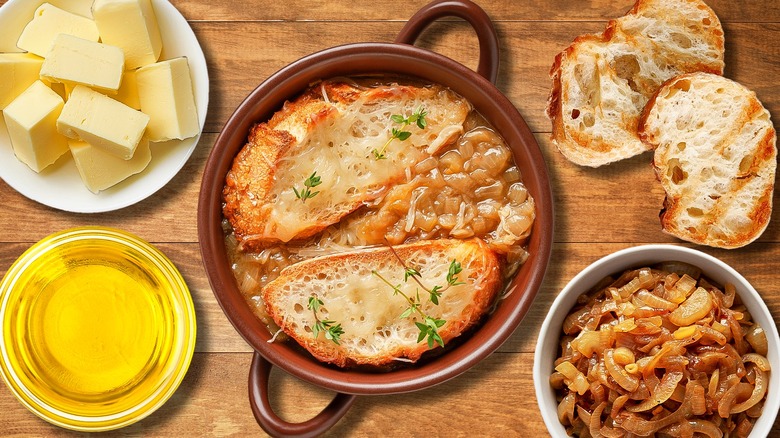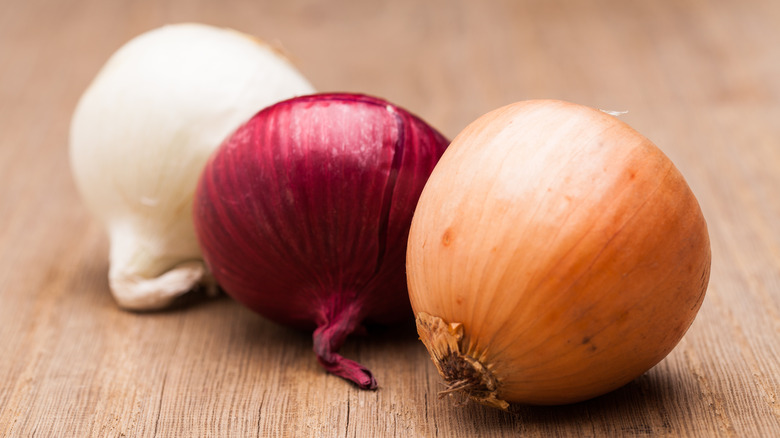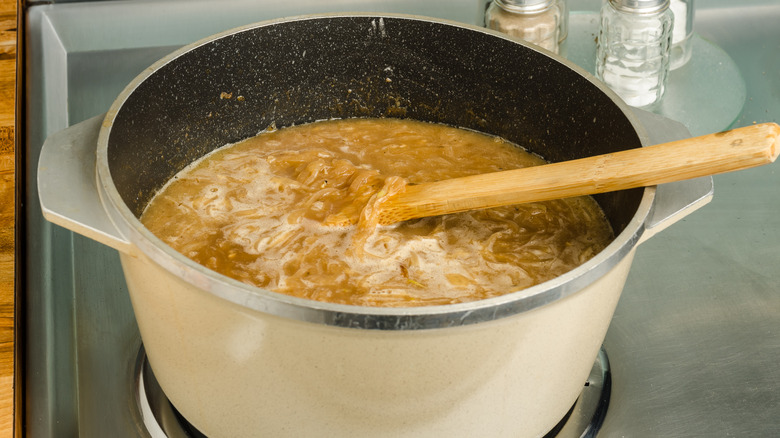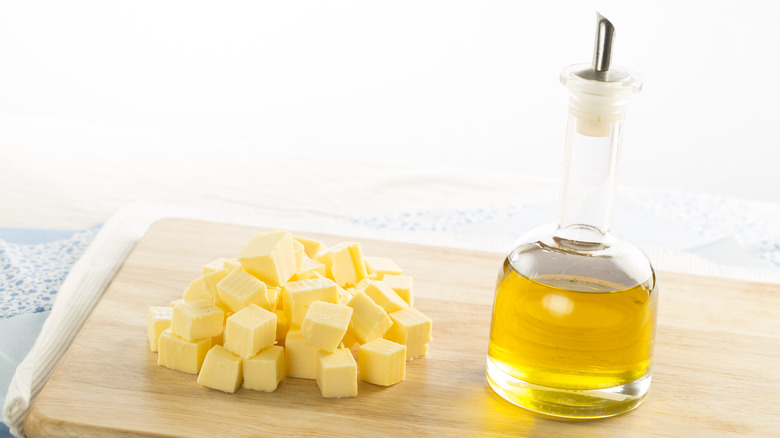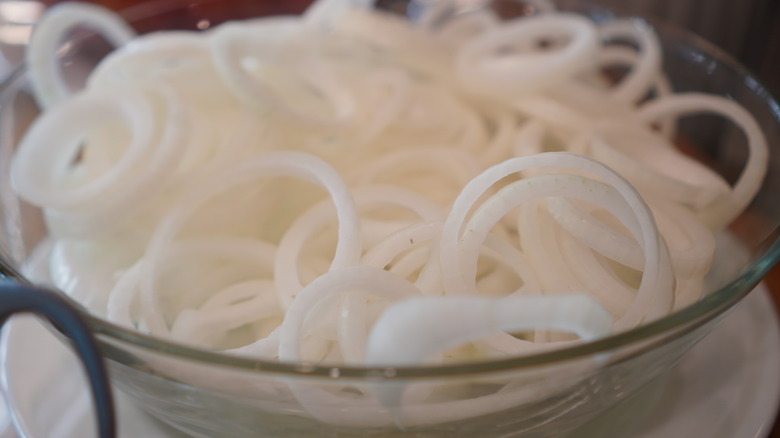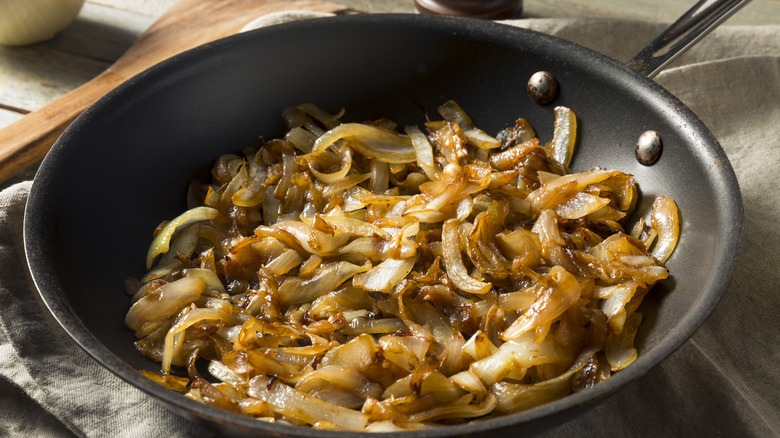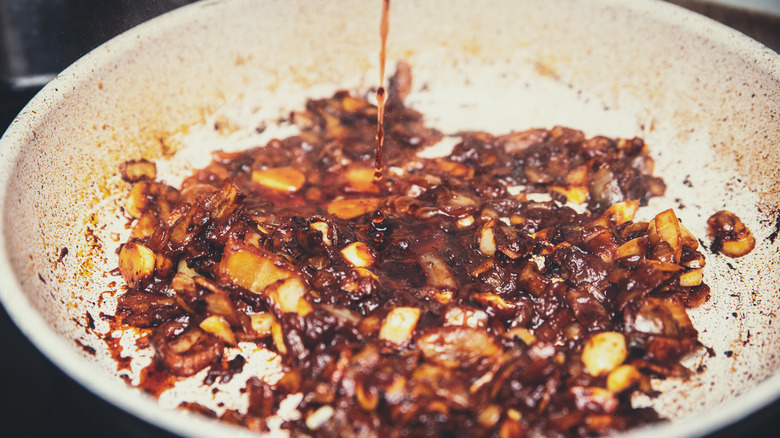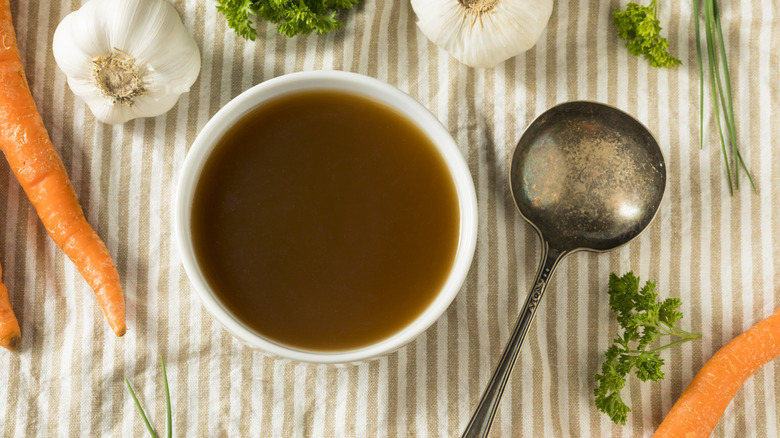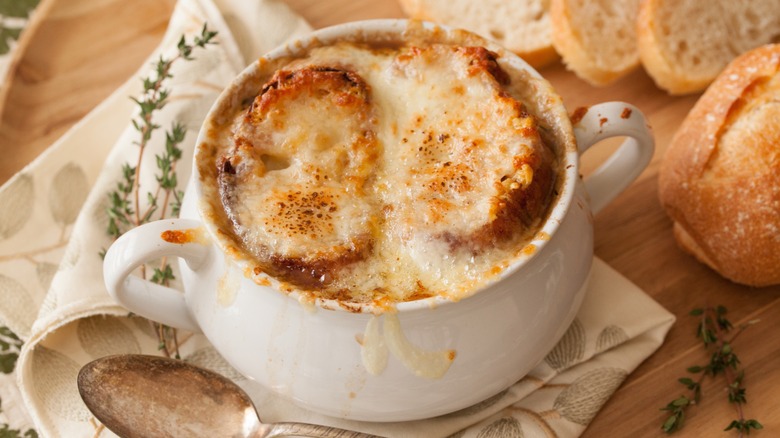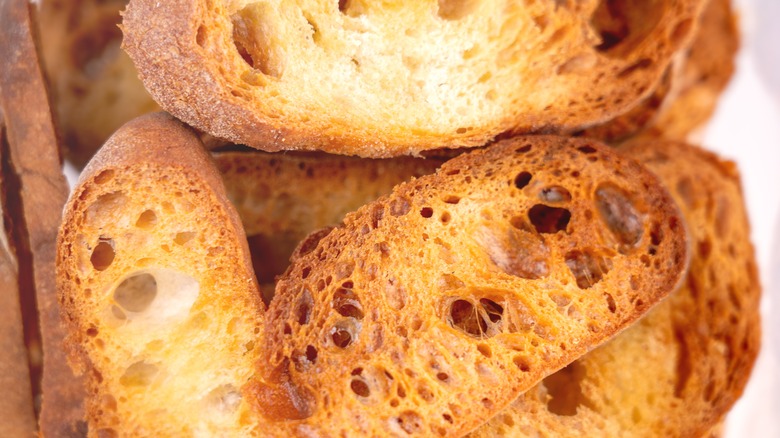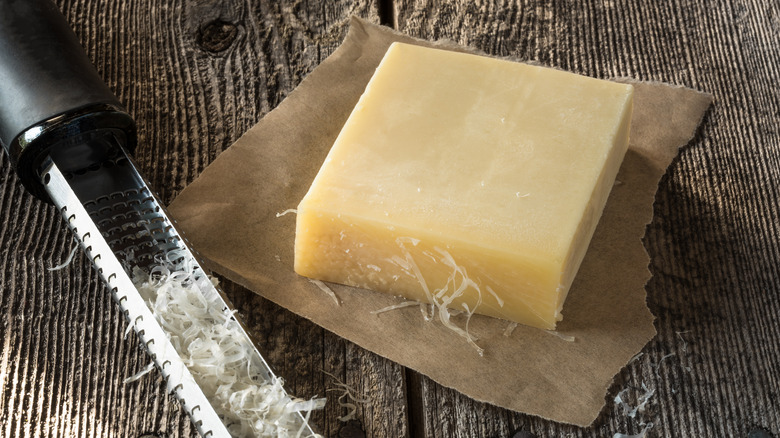10 Tips For The Absolute Best French Onion Soup
Nothing says classic French cuisine more than a steaming bowl of French onion soup. It's the perfect dish to warm up a chilly winter evening but delicious enough to enjoy no matter the temperature outside. The rich, onion-filled broth topped with toasted bread and gooey melted cheese is the perfect comfort food. Despite its name, French onion soup was first made more than 8,000 years ago in ancient Rome. It wasn't served in France until the 18th century.
Soups are typically forgiving recipes, even for novice cooks. They're easily adaptable and, unlike baking, don't require precision for best results. In culinary school, we spent weeks perfecting our soup skills, learning the various foundational cooking techniques necessary for soup success, like sweating vegetables, building layers of flavor, and more. Making French onion soup has additional skills built in. It's a technique you can master, and if you follow these tips, you'll be French onion soup savvy in no time!
Choose the right onions
Choosing the onions that will form the base of your soup is your first step in making the perfect French onion soup. The onions are the foundation on which the rest of your soup is flavored, so it's key that you make the right choice. The most common options for onion soup are red, sweet, and yellow. Each will add a specific flavor profile to your soup. You can use a blend of all three or choose your favorite.
Red onions have a harsher, more intense onion flavor. They caramelize but are easy to burn because of their high sugar content, so pay close attention to them as they cook. Red onions can also discolor slightly when in this state, which isn't a huge problem since they'll be swimming in broth. Sweet onions, like Vidalias, become even sweeter as they're cooked. Yellow onions are the gold standard for making French onion soup. They have a well-balanced flavor, not too sweet or too sharp.
Choose the right pan
Whatever you're cooking, choosing the right pan is always an important first step in the kitchen. The best type of pot to use for French onion soup is a heavy-bottomed pot that can distribute heat evenly. This is crucial in order to caramelize your onions well. Size is another characteristic to consider when selecting a pan.
For French onion soup, you need a large pan that can accommodate the amount of onions you'll need to caramelize, plus the broth you'll add later. Choose a pan with a wide bottom so it can hold the onions in an even layer across its base. If they're piled on top of each other, they won't caramelize properly or evenly. Dutch ovens are popular choices for French onion soup. They have the necessary sturdy bottom, in addition to thick sides and a heavy, tight-fitting lid, all of which help them distribute and hold heat well.
Use butter and olive oil
Caramelizing onions is a huge part of making a killer French onion soup, and that process starts by heating fat in your pan to cook the onions. Both butter and olive oil could work individually for this task, but when they're used together, the result is better caramelization and a more flavorful soup.
Butter is beloved for its ability to add flavor to foods, but because of its low smoke point, it can be tricky to cook without burning. Smoke point is literally the temperature at which fats begin to smoke when heated. And the cooking fat that has the lowest smoke point is butter. Adding olive oil into the mix with butter is an easy way to take advantage of all of the benefits of cooking with butter without worrying about it burning. Olive oil has a much higher smoke point, and adding it raises the smoke point of the butter. You get all of the flavor and browning properties without the burn.
Slice onions evenly
Cutting foods evenly is one of the first rules of knife skills. In culinary school, precision and attention to detail when you're slicing and dicing are emphasized from day one. The idea behind it is simple. Things are more likely to cook in the same amount of time if they're all cut to be about the same size. This is especially important when you're caramelizing onions for French onion soup.
The goal is to cook the onions until they soften and brown. Unevenly cut onions won't cook well. You run the risk of creating smaller slices that are too soft and overdone and larger ones that are not fully cooked and crunchy. Since cooking mellows onion's flavor, you'll likely also end up with some pieces with too harsh a flavor and others that are far too mild. Be careful not to slice your onions too thinly. Slices less than about ¼ inch may cook down and soften so much that they will no longer hold their shape.
Take your time while caramelizing the onions
Caramelizing onions is a task that many cooks find challenging, not because it's technically difficult, but because it requires more patience than culinary know-how. In order to create caramelized onions that are beautifully browned and flavorful, you have to take your time to cook your onions slowly on a lower heat. For impatient cooks, this can be a struggle.
Rushing the process is one of the most common mistakes everyone makes when caramelizing onions. Don't be tempted to turn up the heat to cook them faster. They may brown more quickly, but they won't have the flavor transformation that only occurs when the onions are cooked slowly. Depending on how large you've sliced your onions and what temperature you cook them on, it can take as long as 45 minutes to caramelize onions, though some recipes predict it can be done in as little as 15 to 20 minutes.
Deglaze properly
Deglazing is the process of pouring a liquid into a pan that's already been cooked in. The liquid loosens and dissolves the bits of food and spices that line the bottom of the pan, preventing them from burning and ruining the flavor of your dish. Once the liquid is added, a wooden spoon or spatula is used to gently scrape these loosened bits, also known as fond, away from the bottom of the pan, incorporating their flavor into the other ingredients.
When you're making French onion soup, you'll want to rescue all of the pieces of onion that are stuck to your pan. Adding a splash of white wine, the traditional deglazing liquid for this soup, adds a much-needed acidity to counterbalance the rich sweetness of the onions. Grab a wooden spoon and drag it along the bottom of the pan, making sure you scrape up every browned bit. Here's how to choose the best white wine for deglazing in any recipe.
Use high-quality beef stock
Chicken stock is what many cooks rely on as their cooking liquid of choice for most recipes. It provides a wonderful base flavor to everything from sauces to soups, but you might be surprised that chicken stock or broth is not the traditional choice for making French onion soup. For a rich and savory French onion soup, beef stock is the way to go.
Beef stock is made by simmering beef bones with vegetables for hours. The bones are roasted first for added flavor and color. Don't mistake beef broth for stock. The broth is made by simmering the actual meat instead of the bones. You can use beef broth if you don't have beef stock on hand, but keep in mind that beef broth is only required to contain one part protein for every 135 parts liquid, which means there's hardly any beef in it at all. Using beef broth is definitely an option to consider if it's what you have available, but for a better-tasting soup with a fuller, richer flavor, look for beef stock.
Choose broiler-safe crocks
Serving French onion soup in a cute crock or ramekin is part of the soup's overall charm. Yes, the soup would be just as delicious if served in a regular soup bowl, but there's something about spooning it from an adorable crock that makes it even more enjoyable. It's crucial that you make sure the vessel you choose to serve your French onion soup is broiler safe.
Lionhead bowls or crocks are the porcelain bowls in which French onion soup is traditionally served. They're known for being deep and having thick sides, yet not too wide. Be careful using glass bowls or baking dishes for French onion soup. They are not broiler safe and may shatter under the intense heat. To stay safe, make sure your bowls are broiler safe, not just oven friendly. Oven-safe dishes can typically withstand heat up to 500 degrees Fahrenheit. Some broilers can reach temperatures as high as 550 degrees Fahrenheit, so it's important to only use broiler-safe bowls for French onion soup.
Toast the bread
Broiling French onion soup just before it's served is expected. It's the best way to melt the cheese until it's gooey and brown, and the textural combination of the warm broth, melted cheese, and crispy crouton is out of this world. The best way to achieve this combo is not to rely solely on the broiler to crisp the bread. Toasting the bread before it's placed on the soup is a step you may not expect, but one that is worth the extra few minutes.
You should always choose a sturdy bread to top your French onion soup. Soft or thin bread will absorb the soup's broth quickly, becoming soggy before you have an opportunity to top it with cheese and pop it under the broiler. Toasting the bread before you broil it makes it sturdier and better able to maintain its shape and crunchy texture when added to the soup.
Choose the right cheese
If you're a cheese-lover, French onion soup is the soup for you. As much as we love the caramelized onions swimming in a rich beef broth, nothing tops the thrill of wielding a spoon to break through the crispy bread topped with melted cheese that adorns each bowl of soup. When selecting a cheese to top your soup, it's important to choose a cheese that melts well.
If you're a traditionalist, there's no other cheese option for your soup than Gruyere cheese. Gruyere is a Swiss cheese named after the town Gruyeres in Switzerland. It's made from cow's milk and is typically aged for at least six months. It has a firm texture and is revered in the culinary world for its melting ability. It contains more water than oil, which helps it melt smoothly without separating. Grate the gruyere for best results. It will melt faster and more evenly than larger pieces or slices.
